«From Window to View»
Explorations on the path towards modern architecture | Part One
by Lennart Franz
Today windows seem to live a paradoxal live: The least present they are, the more exquisite they execute their duty. We find those products most valued, which appear nearly absent. On the other hand, contemporary life and architectural practice make high demands of windows. With a variety of different capabilities ranging from stability, heat and sound insulation, usability, sensors and connectivity todays windows rank among high tech devices.
This contrast grants a glimpse into the nature of this – most of the time – invisible object, through which but not at which we often look. Concerning any mechanical or designerly terms its history appears quite clear to the viewer. But as always it is the details which pose the remarkable facets of one of the most diverse and complex evolutions within the architectural sphere. The windows journey throughout history highlights it as quite the opposite of a plain construction component. They are themselves the very objects, enabling us to experience contemporary life, living and working with all kinds of conveniences in a subtle way, that to us appears natural.
Then how come, that windows, whose constitution and application guard the threshold between generosity and pen, are payed so little attention to? Architectural discourse seems to be clamped between “four walls and a roof”. A provocative phrase that headlines the eponymous book by architect Reinier De Graaf, who is a partner at the famous practice Office for Metropolitan Architecture. Within his writings he critically observes architectures status quo concerning its cultural and practical means. At most times, the perception of the discipline is rather selective. Its image is dominated by popular façade designs, iconic building appearances and sometimes controversies. Commonly, the general interest fades if the discourse moves beyond walls and roofs - even though window systems today – technically, aesthetically and in terms of usability – are closer to the realm of science fiction than ever before. Thus, we find the question at hand whether the simple term “window” and its associative orbit still suffices regarding its contemporary nature? Isn’t maybe a turn in perspective towards this capable object overdue?
With “A view, not a window.” Sky-Frame assumes an unmistakable stance in this matter. A topical connection with the window as an artifact as well as with its potential is consequently anchored within this ethos. It extends all concepts of windows into a spatial dimension. Apart from the dictates of functionality and formal conventions, this reception liberates spaces and architectural approaches from the weight of narrow minded terms of designing and building.
An ideal model incorporating those potentials can be found in the concept of “floating spaces”. An Idea, that rose around the beginning of the twentieth century and since disrupted the architectural establishment. The most recognized protagonist in the struggle of modernist ideals was the Bauhaus. It is the vital icon in which visions of the “neues Bauen” and floating spaces fused. But where did the ambitions to radically reform all ideas of a contemporary architecture derived from? What is the story behind the popular formulas of modernism and their intellectual creators?
Throughout the explorations of modern architecture, Sky-Frame dives into the origins of its leitmotiv and its rich and complex history. A motive that also inspires the innovative spirit and quality of Sky-Frames collection. A journey, that is also accompanied by insights into the evolution of the window itself, thus revealing why modern architecture might be unthinkable without this exceptional object.
From Holes to High Tech
Even though the ideal of floating spaces was first explicitly formulated around the Bauhaus era, it already emerged in ancient buildings. The phenomena shows prominently in the temples: Only columns connected the temples foundations with their roofs and gave way to spatial freedom within the buildings main body. Naturally, this approach sprung from the religious and climatic context of edifices in Rome and Greece. To achieve similar architectural liberties elsewhere, the window had to undergo an unprecedented evolution.
Ancient Persian buildings hold remains of the progenitors of the window: Slits and holes that have served as vents or flues in archaic constructions. These early proto-windows were special places within ancient domestic culture: The common Sanskrit term “Ramate” from around 400 years BC meant “recreational spot” or “resting place for the wives”. Yet, functional connotations were secondary. At approximately the same time the latin term “Finestra”, as a circumscription for a hole in the wall poses as the phonetic ancestor for the present-day window term “fenêtre” in Romanic or “Fenster” in Germanic languages. At that time the concept of paned windows was not in sight. Instead, coverings with hide, cloth or plant fibre were fashioned commonly to shield from weather or unwanted attention. Not until 500 years later the Roman “Fenestra” – for the first time explicitly including cast glass plates – initiates the evolution of the contemporary window.
Additional nuances in meaning were included in the Old High German term “Rama” around 1000 AD. The windows at that time were not solely considered passively functioning vents but grew to be of structural importance, as “Rama” refers also to pillar or reinforcement. In the 11th century the development of flat glass gained momentum. The focal point of its development was 17th century England. The rapid progress of glass casting technologies broadens the spectrum of sizes and application possibilities. Its first major role within a larger construction, the large glass plates played at the renewal of Banqueting Houses vitrification which was part of the royal residence of the Palace of Whitehall. In the middle of the 19th century the general popularity of bigger windows rose. In 1851 Londons Crystal Palace – designated to host that years world fair - became the first building almost entirely comprised of vast glass panels.
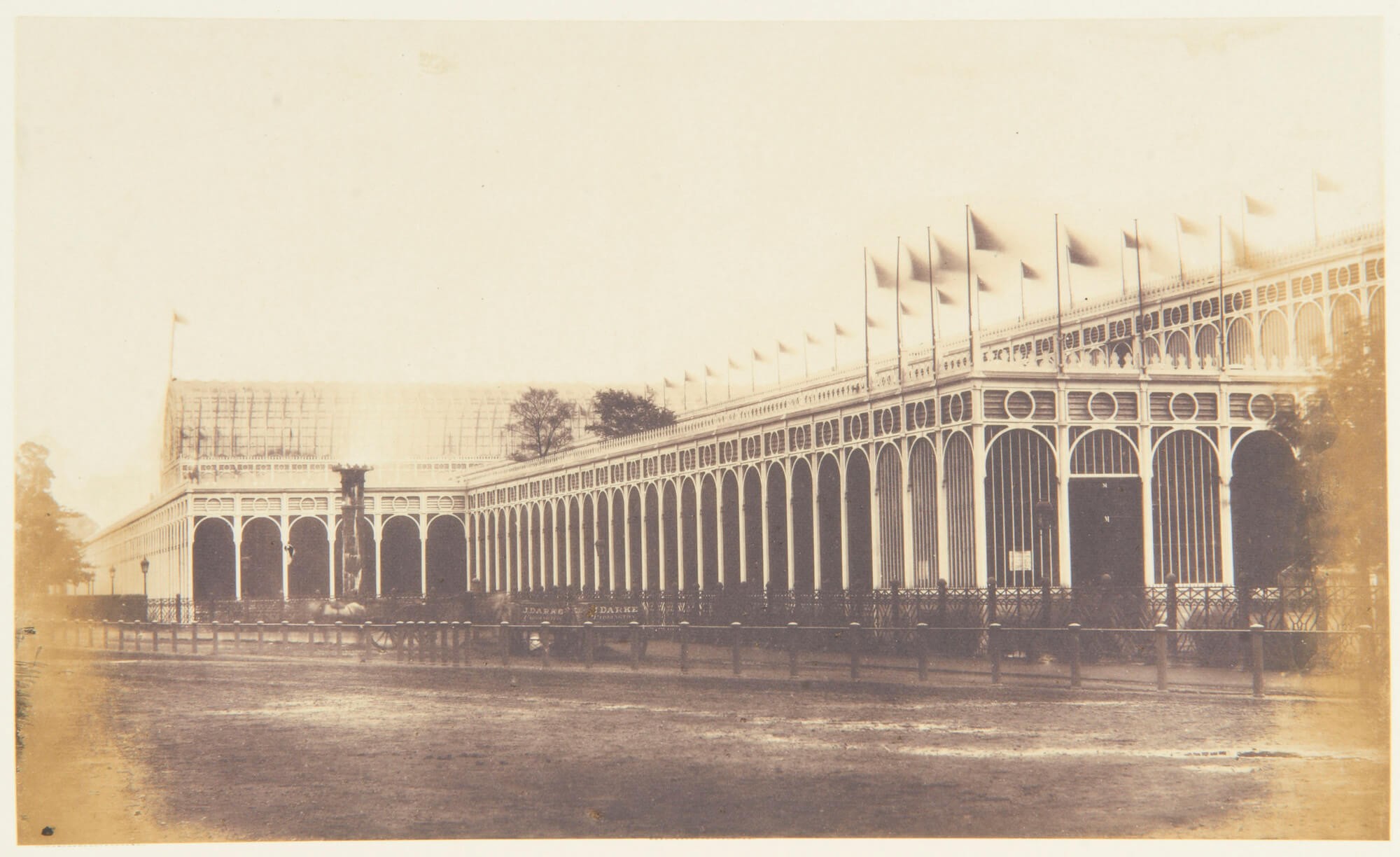 The Crystal Palace in London, designed by Joseph Paxton as the site of the 1851 World's Fair, whose distinct construction allowed more glass than masonry for the first time.
The Crystal Palace in London, designed by Joseph Paxton as the site of the 1851 World's Fair, whose distinct construction allowed more glass than masonry for the first time.
Such architectural liberties derived from a new type of static elements which were to replace brick-built walls as main load bearers: Steel frames ascended to be the new heroes on the architectural horizons at that time. Joined by advancingly capable glass products, both unclosed undreamt possibilities for the design of buildings. The late 19th century tirelessly equipped the arsenal of what would later blossom as modernist architecture. The sheer euphoria concerning the promises of an industrialised future and its fast-paced transformations of life, society and policy fueled its technological advances. Nothing less than the “metamorphosis of mankind” should be the result of the great modern experiment, stated the writer and forefather of science fiction Paul Scheerbart. The setting of this metamorphosis should be a reformed and modernised architectural practice. A new, vitreous eco sphere must be the arena of this evolution, he put down in 1914. His literarily composed anticipation with its utopian appeal sparked the creative impetus of his contemporaries. During the same year, architect Bruno Taut designed the “glass pavilion” which was to be revealed at the Cologne Werkbund exhibition.
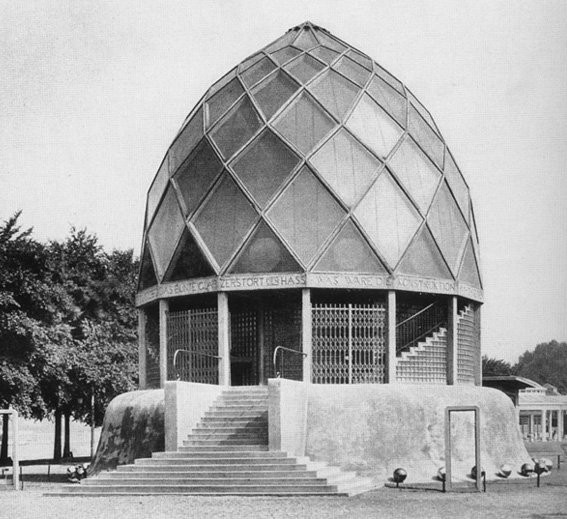 Bruno Taut's built plea for a new glass defined architecture, achieved for the Cologne Werkbund Exhibition in 1914.
Bruno Taut's built plea for a new glass defined architecture, achieved for the Cologne Werkbund Exhibition in 1914.
With its unparalleled extent the exhibition drew in significant attention and visitors on a global scale. Opened in May 1914 it was intended to present the future of arts and crafts as well as architecture to an international audience. While examples of never seen before designs and architectural speculations were presented next to the Rhine, smouldering tensions debouched on Europe’s political stage and erupted in the first world war. Before any of the fairs ideas could find their way to fertile intellectual grounds, they were swallowed by the shockwaves of political reality which drowned these early motions of modernism.
Walter Gropius, advocate of novated architecture
In spite of the heinous years of war, the triumph of reformed ideals in art, architecture and life were merely adjourned. A circumstance that is very well observable if one puts attention to the life and career of one of modernisms most notorious protagonists. Even before the escalation of events of a very young 20th century, tradition and avant-garde contour two diametrically opposed poles. A hearth of historical shearing forces young Walter Gropius was keenly fascinated with. Per architecture, so his early decision, he intends to sustainably shift the societal and cultural status quo. Choosing architecture to be his means of choice seems peculiar, regarding the historical scenario. In the light of Gropius biography we recognize at once why he favours architecture over arms or politics, channeling his visions in the founding of the Bauhaus.
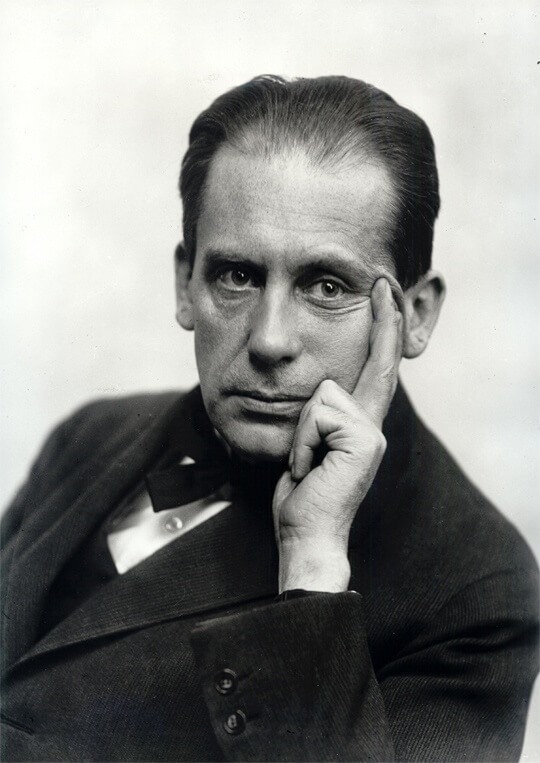 Bauhaus founder Walter Gropius, portrayed in the Bauhaus’ foundings year in Weimar 1919. (Photo: Louis Held)
Bauhaus founder Walter Gropius, portrayed in the Bauhaus’ foundings year in Weimar 1919. (Photo: Louis Held)
Early on his predisposition as the father figure of modernism in architecture finds a prolific surrounding. Walter Gropius was born 1883 in Berlins Tiergarten district. His father himself was an architect but mainly followed a career as a Prussian building councilor. Another family member, famous for his architectural endeavours was his uncle Martin Gropius, a much appreciated and well respected architect and academic. Amid the general construction frenzy of a rapidly expanding metropolis, Gropius found himself shaped by the impressions of the daily scenes and quarrel of workers, machines and activities on Berlins numerous building sites. The opposite of the countless emerging housings he encountered during his summer holidays which he spent on the beaches of Timmendorf in northern Germany. Whereas in Berlin one nearly couldn’t escape the plumes of the excavators and the raw struggles of urban labour, his vacation domicile encircled him with the aesthetical pleasures of sublime bourgeois houses. Even more so, he must have been stunned by the sight of newly erected department store Tietz, back in Berlin. Among Berlins historical visage it must have protruded strikingly due to its excessive glass façade. For the first time in history, the stores display expanded well over a few stories, wide as a common market hall. Within the environment of the Gropius family, the fondness of architecture must have been so exquisite, that it did not take Walter too long that - with great ardor - he swore to emboss his signature in the thread of the 20th century. Still his first attempts were not devoid of obstacles. 1903 he enrolls at an architectural faculty in Munich for his studies, which he soon intermitted.
Instead he went to conduct rather practical exercises: On his relatives property east of the river Elbe, he was commissioned to equip the rapidly expanding grounds with the necessary functional structures. His architectural debut turned out to be more rustic than dignified. And yet he quickly found his talent and took pleasure in acquiring the prevailing rough Prussian tone, dominating the sites. He continued to direct any construction work and found himself attracted to the dashing manners of his Prussian hearted relatives to such an extent, that he joined a hussar regiment in 1904. So sure of himself and victory Gropius went back to Berlin to envisage his studies and a triumphant degree with full honours.
Five years later he abandoned his ambitions a second time. Thanks to a stroke of good fortune he, frustrated and disenchanted, became acquainted with Karl Ernst Osthaus in Madrid, during a self-discovery journey. The architecture aficionado with a love for utopian ideas became Gropius most important patron. Engaging in a critical discourse about the architectural establishment and the condition of the globalized society, Osthaus sensed the spark of a radically different understanding of architecture in Walter Gropius. Stubborn historism and the imminent collapse of overaged forms of cultural and societal life must only be countered by the reunion of art and life, he reminded Gropius.
Through Osthaus’ mediation, Walter Gropius took up a position in the architectural practice of Peter Behrens, based in Babelsberg close to Berlin. Behrens’ office was renowned for his industrial buildings such as the AEG-Werke in Berlin. His office must be considered the elite school for the future cadre of modernist architects. At the beginning of the 20th century many to-be luminaries crossed paths in this practice. Among them: Walter Gropius, Ludwig Mies van der Rohe as well as Charles-Édouard Jeanneret-Gris – later to be known as Le Corbusier. The time spent in Peter Behrens office and his industrial weighty designs were to significantly shape Walter Gropius aesthetical consciousness.
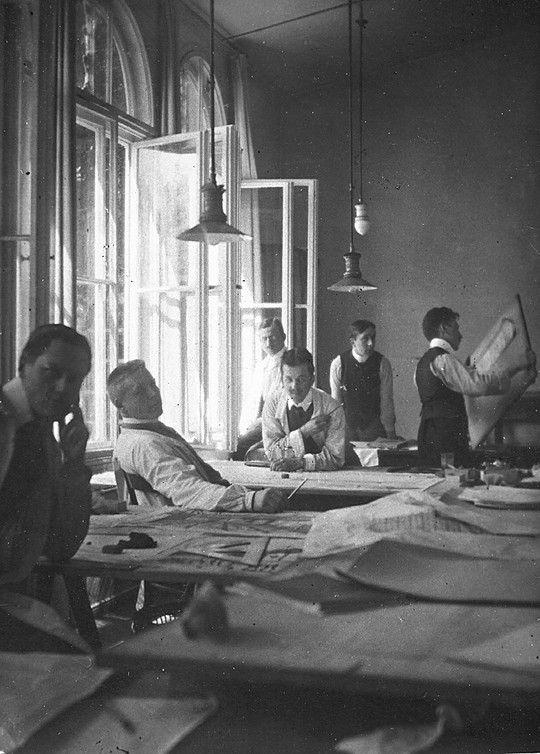 The employees of Peter Behrens’ Neubabelsberg office in 1908. In the foreground is Ludwig Mies van der Rohe, behind him Adolf Meyer, while Walter Gropius - far right in the picture - assessing a construciton drawing.
The employees of Peter Behrens’ Neubabelsberg office in 1908. In the foreground is Ludwig Mies van der Rohe, behind him Adolf Meyer, while Walter Gropius - far right in the picture - assessing a construciton drawing.
Already two years later, Gropius turned his back on Behrens’ practice and worked as an independent architect and designer, developing industrial machinery, wallpapers and basic commodities. In 1910 Karl Ernst Osthaus asked Gropius to join him as a member of the Werkbund. Being appointed curator for a collection of examples of distinguished industrial design, Gropius sense for modern aesthetics and design thrived. Not much later the programmatic differentiation between a rational, systemized design and its antipoles would be of unique relevance. Simultaneously similar concepts exist under the name “neues Bauen” – renewed building – and the “Neue Sachlichkeit” – new objectiveness. Both ideas should later flow into the alchemism from which the Bauhaus’ ideology would ascend. During his Werkbund years Gropius met with the leading architects of the era. His encounters with icons such as Peter Behrens, Josef Hoffmann, Joseph Maria Olbrich, Bruno Paul, Hermann Muthesius and Henry Van de Velde enriched his creative repertoire as well as his rhetorical and political aptness and steamed up his career fervour.
Carried away by the charisma of architectures finest, the superior aura of vitreous buildings and his faith in the impeccability of rational architecture, Gropius set out to design the factory buildings of the “Fagus-Werk” to be an icon of modernism. Together with his colleague Adolf Meyer his concept brought architecture actually a great deal closer to what is today considered to be modernist architecture, consisting of glass and steel. Their design benefited from recent developments of steel frame constructions. The technique offered the liberty to avoid covering most of the buildings body with brick wall in favour of glazed curtain walls. Gropius furthermore decided to counteract established corner designs: He let the curtainwall flow around the buildings corners in lieu of employing regular, boldly masoned corners. He thus stylised a formerly anonymous detail to a revolutionary gesture. With his open corner he opposed the canonical defiance and creates an architecture of yet unbeknown airiness and grandeur. This very details elevates the design of the “Fagus-Werk” to be an internationally recognised symbol for modern architecture. With Gropius’ and Meyers contribution of another model design for a factory as part of the Werkbund exhibition, Gropius life ties to the dying down of early modernism due to the outbreak of world war one.
 With the Alfelder Fagus-Werke Gropius and Meyer spawned a technical and aesthetical pioneer of modern architecture.
With the Alfelder Fagus-Werke Gropius and Meyer spawned a technical and aesthetical pioneer of modern architecture.(Photo: Edmund Lill)
Highly decorated but injured and deprived of any sympathy for conservative ideas and their manifestations, Walter Gropius returns from his front service in 1918. Under the lucid impressions of what he had witnessed in the trenches and on the battlefields, he turned against the powers which he held responsible for the destruction of Europe and the world. He become a member of the workers council for arts and fiercely fought for the cultural revolution under architectures rule in the German revolution of 1918 and 1919. But his eager commitment wasn’t meant to flourish until he was appointed director of the academy of fine arts in Weimar. A position he inherited from his former Werkbund fellow Henry Van de Velde. His imperturbable belief in the superiority of an institutionalised avant-gardist architecture would now become reality. In 1919 he renamed the grand-ducal Saxonian Institution to become the state Bauhaus in Weimar.
The Bauhaus – Core of Modernism
In his newly founded institution Gropius immediately began fusing his avant-gardist visions with the latest technical armamentarium. Constructing the Fagus-Werk, he had already utilised the uncoupling of the classical relationship between static needs and conventional walls. This kind of liberty, which was a designerly one as well as an intellectual one, Gropius continuously implemented into the Bauhaus education. A ground-breaking combination to attract notice to a new intertwingularity between building and living. In his role as the Bauhaus director, Gropius created an entirely new system to qualify of architects in ways of thinking and operating modern. In his curricula he merged his experiences and visions to become the essence of his modernism.
In its making the Bauhaus’ benefited of Gropius intellectual, political and professional assets, both his personal ones as of his acquaintances. A repertoire of important instrumentality to navigate the school through its early stages. Leading the institution to becoming a recognised academic apparatus Gropius gathered kindred spirits in the orbit of his venture: Reformists and avant-gardists from a diverse range of disciplines and cultures were to put together a contemporary course structure. Its most distinctive feature was the strict omission of historismish or traditionalist craft romanticism. The curriculums concentration lay upon the schools agency for reducing the functionality and form to be a perfect balance between purpose and guise.
At that time, the structural and textual fashion next to the strict systematisation of teaching posed a considerable innovation. It was based on a gradual mediation of knowledge and skills which was also intended to foster the students original thinking. Ideologic settings, simple imitation and normalisation were disestablished in favour of the students individual developments.
Following the establishing of an interdisciplinary tenet Gropius strived to arrange for a rich cultural live accompanying the Bauhaus’ daily routines. But his concerns of an barren cultural landscape was unfounded: Unlike the strong hierarchy of the rather Prussian tone within academic institutions at that time, the Bauhaus’ sphere produced a naturally diverse ecosphere of discourses concerning various topics. Many fruitful ideas and innovations sprung from this homemade culture of debate. The prevailing habits among students, tutors and professors quickly swung out of Prussian linearity. Instead of public holidays, cultural events and ceremonies burgeoned and a veritable schedule of ritualesque occasions accumulated. Though this process and its phenomena was highly unique it did not result in forming the Bauhaus community to be a secretively elitist enclave with conspirational touch, but rather making it an open cultural platform. Thus the Bauhaus made itself approachable for the public. That was not least a manoeuvre confirming the schools popularity and thus, its political leverage.
Alongside the cultural vitality of the Bauhaus’ its productivity in terms of architecture and design work would only just gain traction. Projects in the fashion the well-known “Haus Sommerfeld” and the “Musterhaus am Horn” determined the building practices of the Weimar period. The design of the latter came close to what could be named a debut of the later distinctive Bauhaus style.
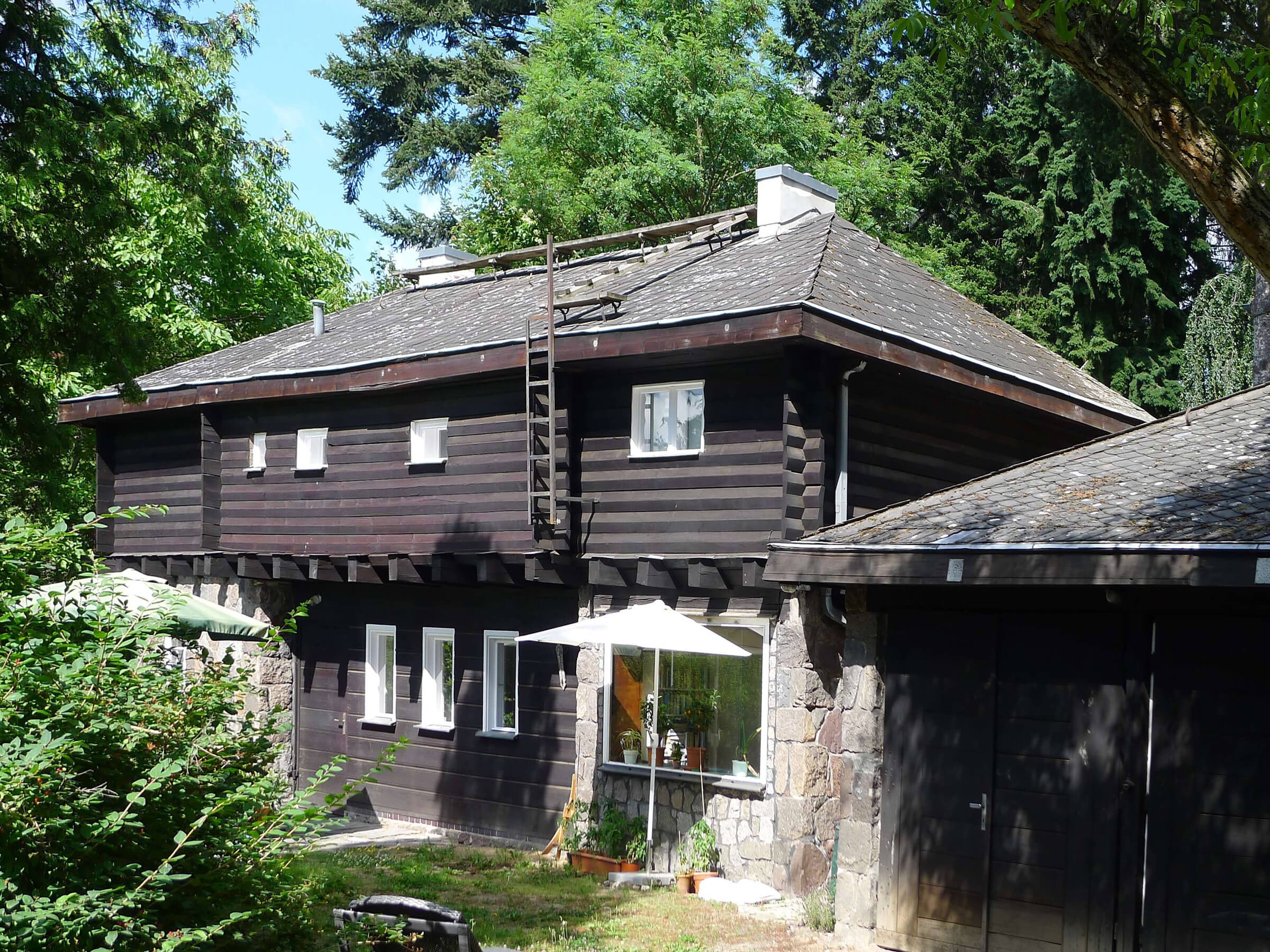 Haus Sommerfeld was built between 1920 and 1921 by Meyer and Gropius in Berlin Lichterfelde.
Haus Sommerfeld was built between 1920 and 1921 by Meyer and Gropius in Berlin Lichterfelde.(Photo: Bodo Kubrak)
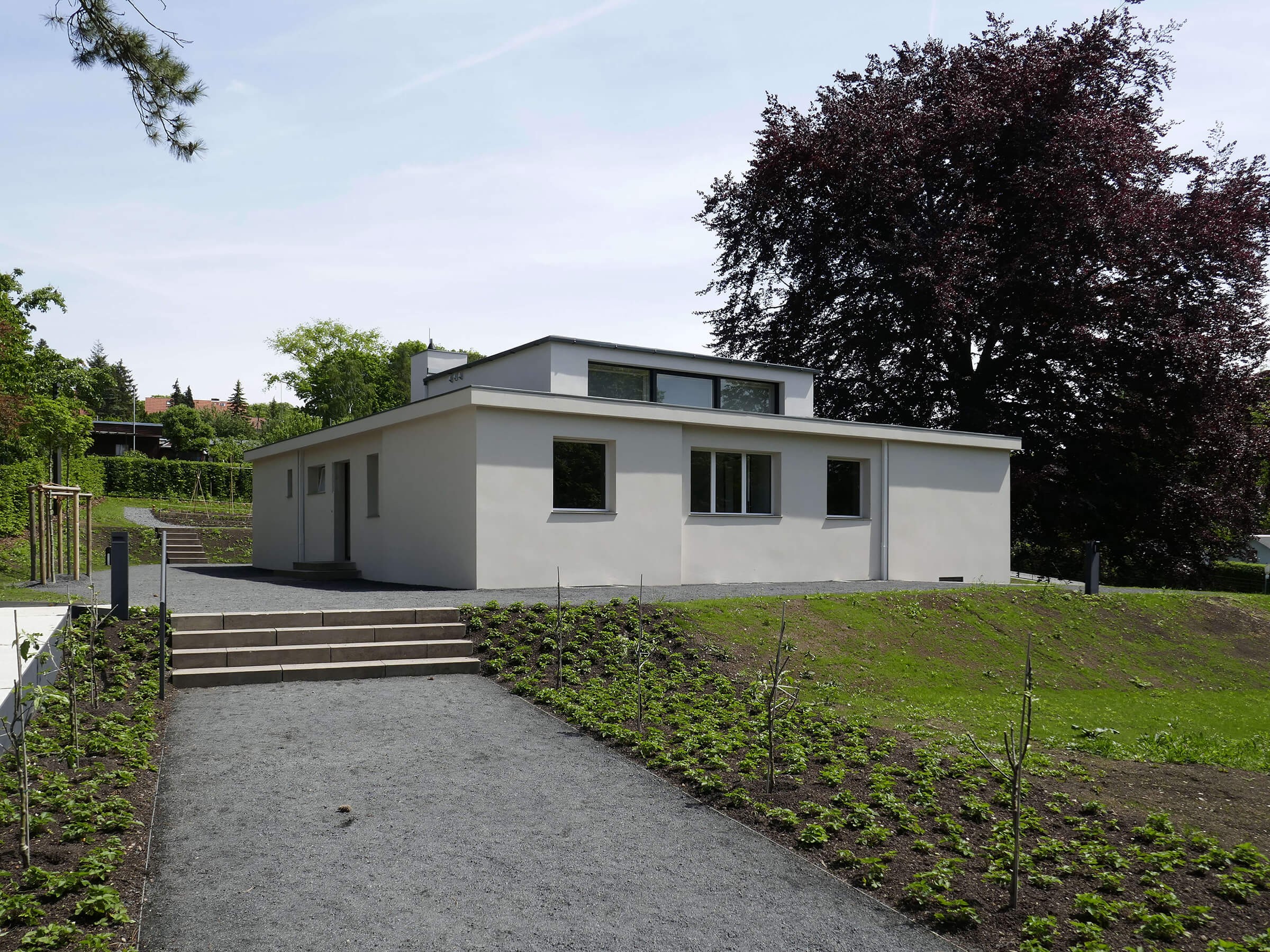 In the prototype Haus am Horn, built on the occasion of the first Bauhaus exhibition in 1923 designed by Georg Muche, the Bauhaus' architectural ideals are already more evident.
In the prototype Haus am Horn, built on the occasion of the first Bauhaus exhibition in 1923 designed by Georg Muche, the Bauhaus' architectural ideals are already more evident.(Photo: 1971markus@wikipedia.de)
Its proportions, layout and reduced aesthetics provide a sense of the Bauhaus’ idea of systematised planning. Its way of applying windows and the formal composition of the building seems much like a quantum leap compared to “Haus Sommerfeld”. More precisely, the exemplary “Musterhaus am Horn” condensed the Bauhaus’ spirit. It was cubic, functional as well as affordable and constituted one of the first buildings coming from a seamless collaboration of the Bauhaus’ different teaching studios.
However, further projects fell ill due to the rapid corruption of Weimars political environment. The reinvigorating conservative camps set out to desiccate the schools funds, which they found to be an unsaintly palladium of communism, globalism and boisterous degeneration. In 1925 the institute was forced to swerve to the city of Dessau. Luckily, directly after resettling the schools business prospered, quickly expanding its building portfolio and its product design attempts - owed to those who, even after the schools close-down, should lend their names to its heritage: Marcel Breuer, Mart Stam and Ludwig Mies van der Rohe, with their minimalist designs, widened the Bauhaus collection. On the architectural side, the schools director himself produced the design for the institutes brand-new domicile. His draft incorporated any essential characteristics of the contemporary construction habits. The cubic glass and steel mélange was inaugurated in 1926. Alongside Gropius and Meyers plot for the Fagus-Werk, the Bauhaus Dessau carries the tokens of a modernist approach most prominently. One of its outstanding features: The lack of all too expressive traits. Following the schools main building, the professors quarters, the “Meisterhäuser”, joined this ascetic mode.
 After leaving Weimar, the Bauhaus’ Dessau new main building, planed by Walter Gropius himself, was erected between 1925 and 1926.
After leaving Weimar, the Bauhaus’ Dessau new main building, planed by Walter Gropius himself, was erected between 1925 and 1926.(Photo: Aufbacksalami@wikipedia.de)
 The structure of the Dessau Bauhaus clearly shows that Bauhaus’ architecture was guided by a systemic concept of architecture whose modular elements and motifs could be applied to various building situations. (Photo: Ladiszlai@wikipedia.de)
The structure of the Dessau Bauhaus clearly shows that Bauhaus’ architecture was guided by a systemic concept of architecture whose modular elements and motifs could be applied to various building situations. (Photo: Ladiszlai@wikipedia.de)
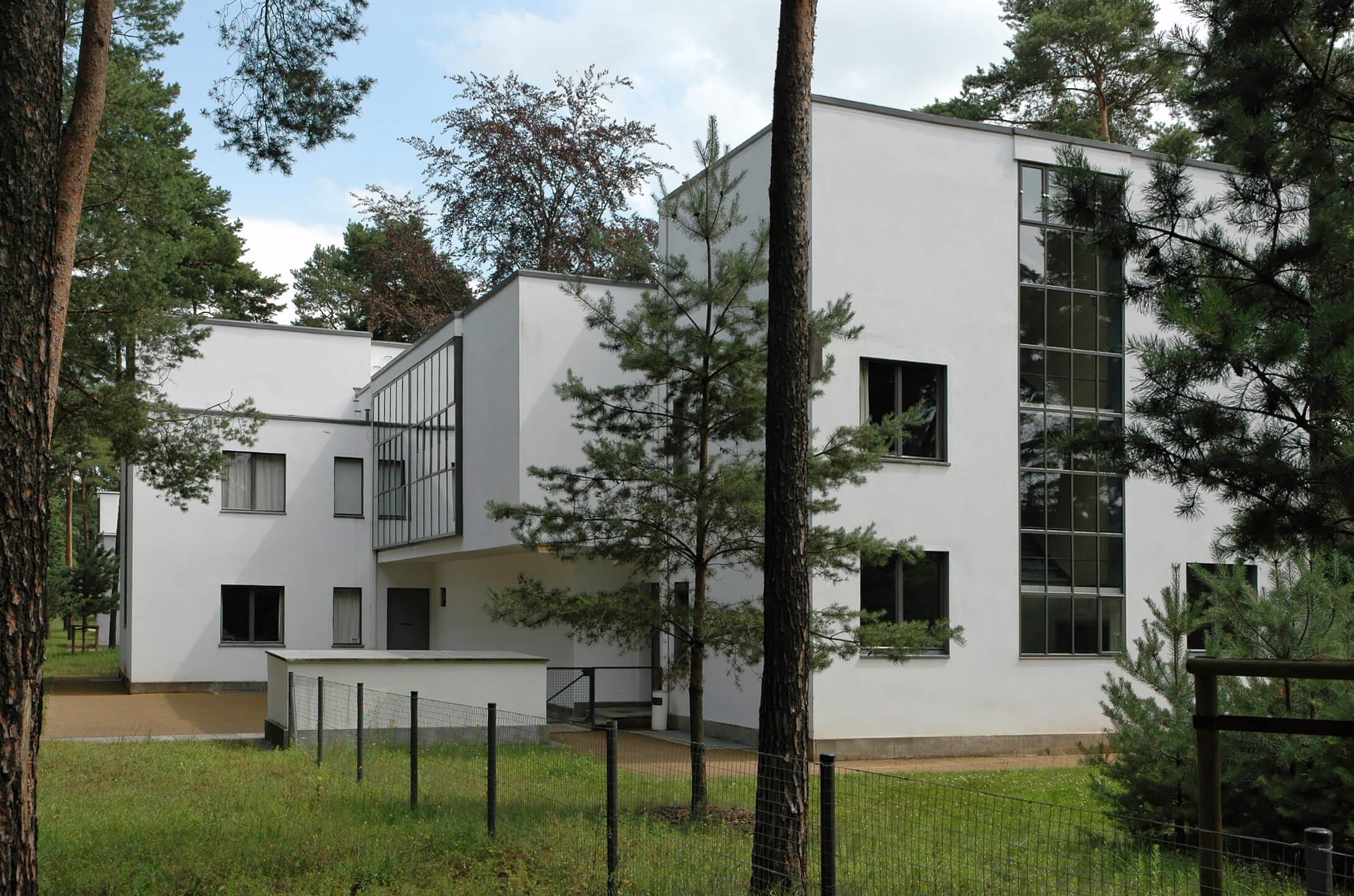 The Master Houses, designed by Martin Gropius, served not least as a testing ground for the new approaches of the Bauhaus. His systemic, formal and aesthetic ideas were implemented in the buildings. (Photo: Harald909@wikipedia.de)
The Master Houses, designed by Martin Gropius, served not least as a testing ground for the new approaches of the Bauhaus. His systemic, formal and aesthetic ideas were implemented in the buildings. (Photo: Harald909@wikipedia.de)
With the resignation from directors post, the departure of Walter Gropius from the institutes ranks introduced the Bauhaus further differentiation. Whereas Gropius kept architecture and product design in sight, the schools new director, architect Hannes Meyer, shifted focus towards planning and building. In Meyers opinion, the schools direction was overly elitist, cultivating an avant-garde driven narcissism. Countering this development he declared that common needs must be regarded over demands for luxury goods: “Volksbedarf statt Luxusbedarf!” In this proclamation he anchored a new down-to-earth design approach, a new ethos to guide the Bauhaus’ theory and practice. Following the years of Gropius withdrawal until 1930, Hannes Mayer transformed the institution into a clergy of socio-idealistic functionalism. Architecture and design were to be performed for the welfare of the many.
An approach that shortly induced efforts among the Bauhaus’ adversaries, trying to annihilate what was perceived as a communist forge. With the seizure of power by the national socialist German workers party Hannes Meyer was depleted of his post. For the last three years of the schools persistence, Ludwig Mies Van der Rohe became Meyers successor. Despite ceaseless chicanery of students and teachers he untiringly worked to ensure the Bauhaus existence. His final effort consisted in bringing it to Berlin and privatising it. By denationalising it, he aspired to take the parties alertness off of the Bauhaus. Contrary to the schools and Van der Rohes enduring efforts, the institute was shut in 1933, as its liberal and avant-gardistic maxims posed an excessive and moreover, a too conspicuously antagonism to the nationalist ideals.
Separate from the drastic events, the disorganization of the Bauhaus did not implicate its total vanishing. Its break-up drove its students, teachers and fellow campaigners to scatter across the globe. The forceful de-localisation of the Bauhaus actually entailed the large-scale spreading of its ideals, theories, methods and protagonists. One of the most visible, concentrated examples of the schools internationalisation by means of architecture is the White City of Tel Aviv – but also atop the Monte Veritá in Switzerland. The Bauhaus evolved into an international phenomena and merged into the modernist movement.
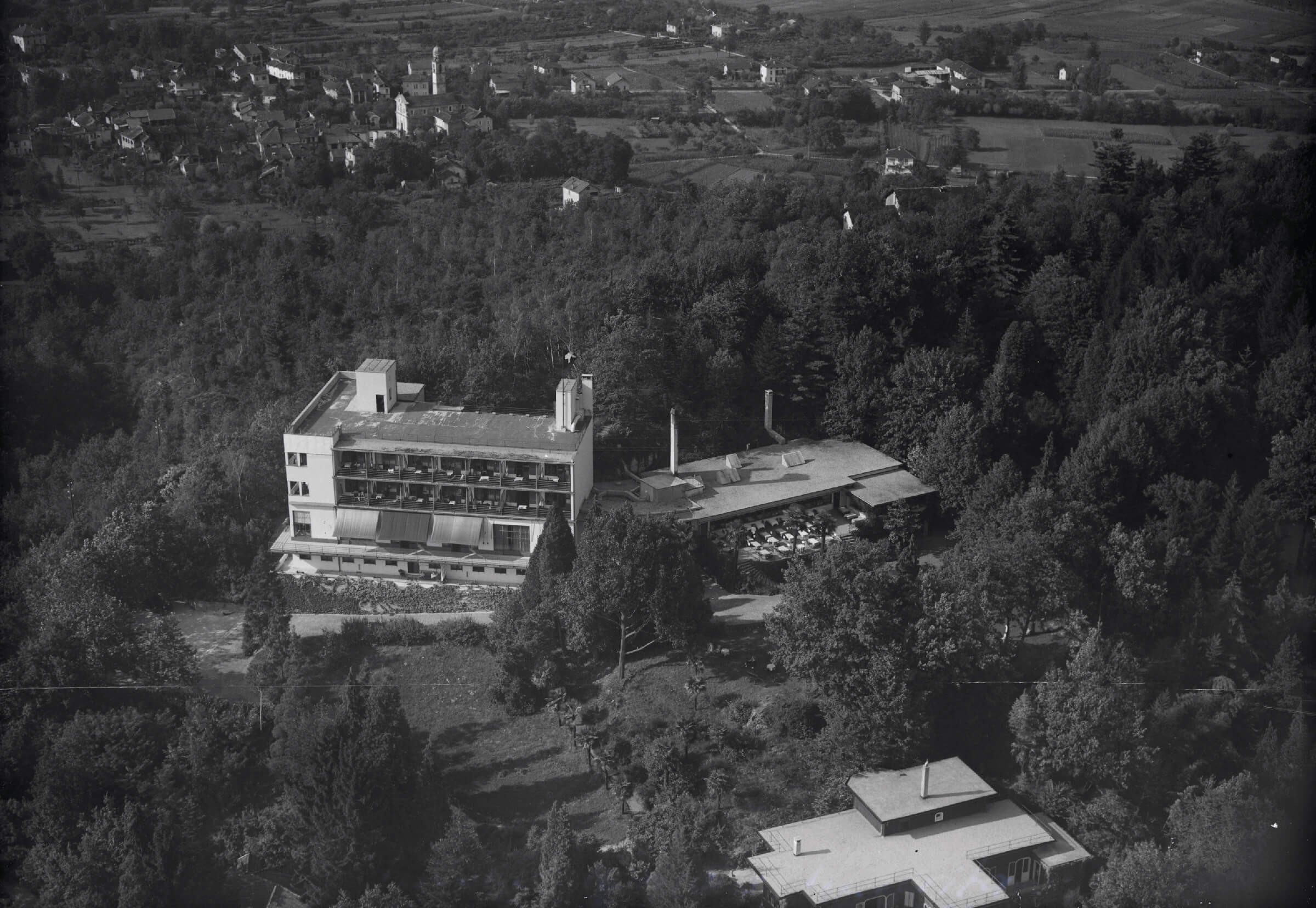 The Bauhaus style also attracted a lot of attention internationally, as on the Swiss Monte Verità. Well frequented by members of the European life reform movement, the Bauhaus style was the groups architectural counterpart. The complex was planned by Mies van der Rohe, executed in 1928 by Emil Fahrenkamp. (Photo: Werner Friedli)
The Bauhaus style also attracted a lot of attention internationally, as on the Swiss Monte Verità. Well frequented by members of the European life reform movement, the Bauhaus style was the groups architectural counterpart. The complex was planned by Mies van der Rohe, executed in 1928 by Emil Fahrenkamp. (Photo: Werner Friedli)
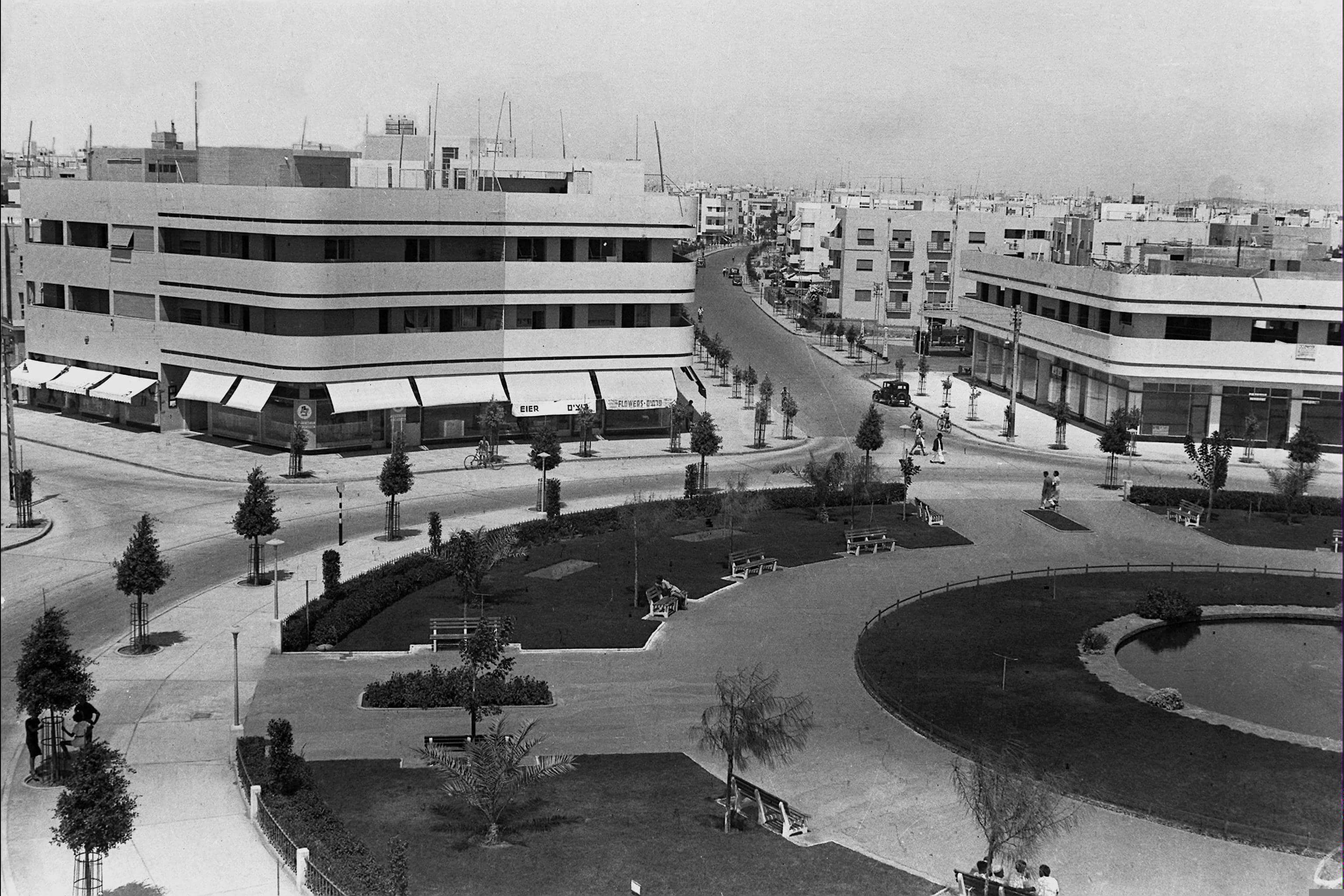 From 1933 onwards the "White City" was created in Tel Aviv. An extensive collection of buildings in the Bauhaus and International style, mostly built by Jewish architects who had been banned from working in Germany. (Photo: National Photo Collection of Israel)
From 1933 onwards the "White City" was created in Tel Aviv. An extensive collection of buildings in the Bauhaus and International style, mostly built by Jewish architects who had been banned from working in Germany. (Photo: National Photo Collection of Israel)
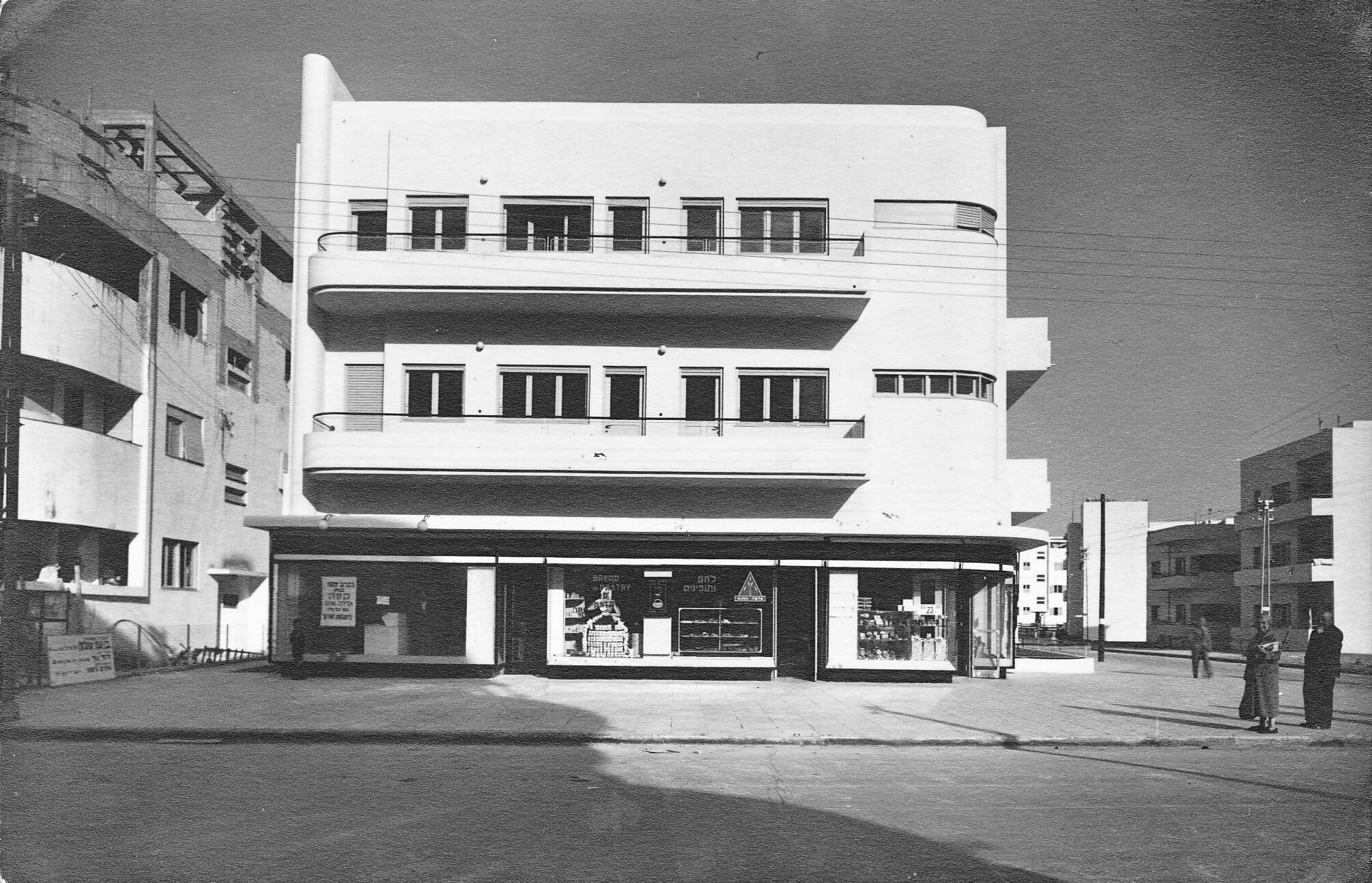 Tel Aviv's mayor Meir Dizengoff was in charge of the execution of the wider urban concept. Thus becoming the godfather of the "Dizengoff Square", around which many of the new buildings were concentrated. (Photo: Nitza Metzger Szmuk)
Tel Aviv's mayor Meir Dizengoff was in charge of the execution of the wider urban concept. Thus becoming the godfather of the "Dizengoff Square", around which many of the new buildings were concentrated. (Photo: Nitza Metzger Szmuk)
Modernism as an international vision
The Bauhaus’ primary legacy does not consist of the production of countless buildings, which demonstrate its leading role in modernism. It rather consists of the ignition spark it produced to initiate a diverse typological evolution in architecture, design and aesthetic culture.
Walter Gropius, his comrades and the Bauhaus created the founding elements upon which modernism should later seek its further differentiation. Generously wide window panes, curtain walls, open corners, visual airiness and increasingly transparent buildings are its inherent properties. Within the latter might have lain the most radical feature: The creation of spatial ensembles in which exterior and interior coalesced. The quantity of Bauhaus-inspired innovation of airy, bright and functional open plan approaches was unexcelled. The sum of its conceptual and aesthetical concepts fused into the idea of the floating space. An idea whose prosperity – even if not formulated by Gropius himself – nevertheless flourished thanks to his renewed approach towards architecture and design.
In addition, the Bauhaus effected a long overdue disruption of the design establishment. Abolishing overaged professional profiles and expectation, the institution loosened the intellectual and societal soil for the upcoming works and ambitions of its alumni. It provided the movement of modernism with the necessary vigour and provided a lasting symbolic charisma. Both supporting its academical stand and granting authenticity. Only the sum of those circumstances could enable the contouring, variations and evolution of modernism and ensue its influence on our contemporary reception of spatial aesthetics.
With their timeless design Sky-Frames creations touch the ideational and formal visions of the Bauhaus. Although inspired by modernisms history, the slender and swiss-made windows did also emancipate from their models and themselves ascended to mastery. Over two decades the team surrounding company founder Beat Guhl observed what influenced the evolution of architecture and the transformation of the factors that pose constant challenges to the discipline and its agents. The Frauenfeld based company collected a remarkably dense corpus of expertise regarding architecture, interior design and the latest technologies affecting both fields. Only with its astute eye, even for the most sublime developments and potentials, made-to-measure functionality, technical know-how and aesthetic superiority, it is possible to tie to the pristine philosophy of modernism.
The smoothly running sliding windows, which reside nearly unseen in the buildings body are opening up spaces and buildings, connecting landscapes to the interiors of homes. But in order to do so, a sensitive receptivity for inspiration as well as a sedulous spirit can provide such elements, which grant openness and diverse accessibility and functionality to spaces, buildings and districts. Only those leaving the comfort zone of well-treaded paths of generic design, are capable of enabling architects, dwellers and communities to think and act sustainably. The innovative products, consisting of delicate frames, high-tech glazing and their connectivity constitute irreplaceable instruments in mastering suchlike ambitions. They are fit to serve the aesthetic plaisir of breath-taking panoramas and the desire for freedom and vastness. But they are also capable of granting protection, as demonstrated by Sky-Frames Hurricane-Collection that provides safety even in the face of elemental forces. Both is tightly interwoven with the power and beauty of nature. For it to sustain, the swiss company continuously optimises every product line: Technological excellence and a responsible treatment of all resources enables us to create floating spaces that conjoin contemporary life with a healthy nature.
The source of inspiration and fuel for an inexorable progress is modernisms complex history and its countless utopias. A history which by no means ceases with the Bauhaus. Instead, its most significant developments starts with the global triumph of the schools ideas. Anywhere in the world, designers refined architectures humanistic concept to become an aesthetically as well as ethically fit charter for sustainable societies. Among the ranks of iconic architects and designers, one protagonist certainly stands out. Albeit being a coeval of the Bauhaus, architect Richard Joseph Neutra went on to find his own distinct style and interpretation of the concept of modernism. His distinct way to advance architecture – its motives and purposes – will lead our way, whilst we explore the path of modernism and witness the metamorphosis of the window from a simple artefact into the statement “From window to view.”

